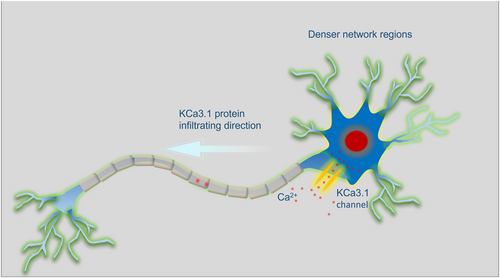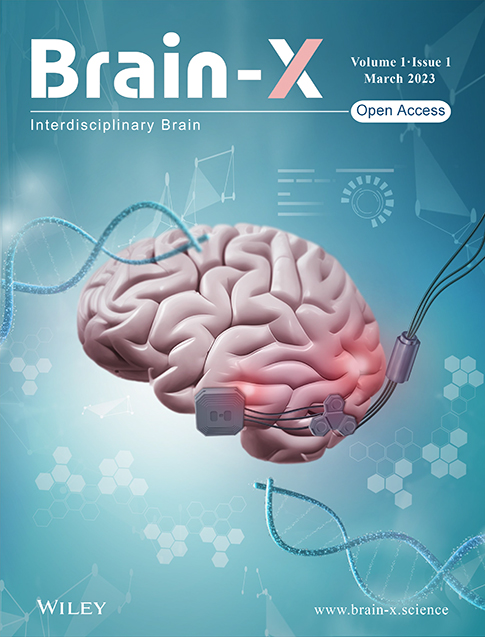Rhythmic calcium ion activity related to glioma growth reveals the mechanism of ion transmission
[Correction added on 27 June 2023, after first online publication: The copyright line was changed.]
Considering their substantial morbidity and mortality rates, tumors of the brain and central nervous system (CNS) are among the most fatal cancers.1 Among them, gliomas are the most common malignant forms of cancer. Regarding the growth mechanism of gliomas, the surrounding microenvironment and local network activity among tumor cells are key areas of interest. The oscillations of brain activity are also directly related to tumor growth and can be induced by external stimuli. Out of the relevant signals and biomarkers, calcium ion (Ca2+) channels and signaling dynamics show the greatest correlation with oscillatory brain activity. The activity of intracellular Ca2+ oscillations can be used to characterize promoters like ASCL-1 or neurogenin-2, which are related to luciferase reporter genes.2 Characterizing these promoters helps to link the micro genes information and macro detectable information.
Recent research has focused on glioma cell network communication via Ca2+ transients and KCa3.1, a type of Ca2+-activated potassium ion (K+) channel.3 These network communications can protect glioma cells after surgery, leading to local tumor recurrence. Glioma cells are closely connected to multicellular networks, and Ca2+ transients are transferred between individual cells through interconnecting tumor microtubes. This results in rhythmic Ca2+ fluctuations that periodically activate signaling pathways like MAPK and NF-κB, increasing the proliferation of tumor cells and promoting tumor growth. Glioma cells that display such periodic Ca2+ activity are known as periodic cells. Inhibiting cellular entry and chelation of Ca2+ or inhibiting tumor cell connectivity via gap junctions can also strongly reduce the proliferation of glioma cells. As a result, the rhythmic Ca2+ activity in glioma cell networks is a tumor cell-autonomous functional state, which is not affected by the external environment.
Functional tumor cell networks have scale-free and small-world properties, the two most common complex network features. These properties reflect the center and surrounding structures as the glioma to some extent. If the clustering coefficient of a certain network is significantly higher than that of the corresponding random network, and the average path length is equal, then the network can be classified as a small-world phenomenon. Networks where most connections are concentrated in a small number of centers are called scale-free networks. With these scale-free and small-world properties, periodic glioma cells at the center of networks are more resistant to random damage, as the center is protected in this network structure.
This protective mechanism has been analyzed using laser ablation as well as Ca2+ monitoring to detect the number of communicating cells before and an hour after ablation.3 Only the ablation of periodic glioma cells was shown to reduce Ca2+ activity and functional network size in Ca2+ recordings. KCa3.1 inhibition limits periodic cell growth, which reduces global Ca2+ activity. As shown in Figure 1, the denser network regions are most important for glioma growth and the Ca2+ activity reflects the infiltration. The Ca2+ activates potassium ion (K+) channels and creates a direct relationship between the two kinds of ions. These results suggest that the proliferation rate and viability of glioma cells are significantly influenced by the activities and concentrations of Ca2+ and K+. As has been found, glioma cells expressing the KCa3.1 protein accounted for 4.8% of all tumor cells in concentrated network regions, but were largely absent in the infiltrated area.3 This clearly shows that the activities of these ion channels can be sensitive to infiltration.

Dynamics of Ca2+ activity in the glioma network.
Gliomas account for over half of all malignant CNS tumors, which are characterized by invasive infiltration.4 Therefore, investigation of the inherent promotion and suppression mechanisms of cell proliferation in gliomas will inform the design of rational therapeutic regimens and diagnostic techniques.
The dependence of glioma cell networks on periodic Ca2+ activity presents an opportunity to develop novel therapies, such as KCa3.1 channel inhibitors. Inhibition of KCa3.1 channels can reduce the percentage of periodic cells in experimental gliomas and limit the global activity of Ca2+. This in turn could reduce cell proliferation and slow tumor growth. Two inhibitors of KCa3.1, TRAM-34, and senicapoc reduced both the prevalence of periodic cells and their Ca2+ levels.3 As these directly inhibit the Ca2+-activated K+ channel KCa3.1, they have the potential to become targeted drugs.
Ion activity can directly influence the elemental composition of the glioma microenvironment. Based on this knowledge, novel diagnostic methods have been trialed for the identification of glioma tissues. For instance, laser-induced breakdown spectroscopy has been proposed to detect the infiltrating boundary of glioma tumor and spectral lines related to calcium, potassium, and other elements, while molecular fragment bands have been verified to characterize differences in brain tissue.5 The diagnostic methods based on the spectral signal of ions and elements are much convenient and the application cost is low. Several experiments have given credence to the theory that ion activity and elemental composition are valuable biomarkers for glioma diagnosis and treatment.
AUTHOR CONTRIBUTIONS
Geer Teng: Conceptualization; Formal analysis; Project administration; Validation; Writing – original draft; Writing – review & editing.
CONFLICT OF INTEREST STATEMENT
The author declares no competing interests.
Open Research
DATA AVAILABILITY STATEMENT
Data sharing is not applicable to this article as no new data were created or analyzed in this study.




